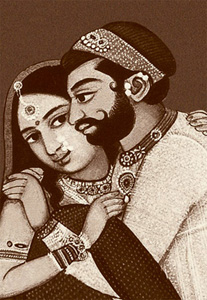Nayikas and messengers

Nayakasahaya-dooti-karma Prakarana

 hen
kama is practiced by men of the four castes according to the rules of lawful marriage with virgins of their own caste, and according to society's customs, it becomes a means of acquiring lawful progeny and a good name. But the practice of
kama with women of a higher social level, or with those previously enjoyed by others, even though they are of the same class, is prohibited. The practice of
kama with women of a lower standing, or with excommunicated women is accepted; but
kama with prostitutes and women previously enjoyed by others for carnal pleasure only, is neither recommended nor prohibited.
hen
kama is practiced by men of the four castes according to the rules of lawful marriage with virgins of their own caste, and according to society's customs, it becomes a means of acquiring lawful progeny and a good name. But the practice of
kama with women of a higher social level, or with those previously enjoyed by others, even though they are of the same class, is prohibited. The practice of
kama with women of a lower standing, or with excommunicated women is accepted; but
kama with prostitutes and women previously enjoyed by others for carnal pleasure only, is neither recommended nor prohibited.
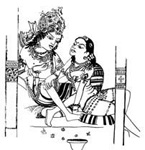
The royal couple in a relaxed mood look fondly at each other.
Nayikas: Heroines
Nayikas are of three kinds: kanya, maid; punarbhu, single woman, either widowed or deserted by her husband, or who has left her husband; and veshya, a prostitute or courtesan.

In Search of a Special Nayika
Gonikaputra opines that there is a fourth kind of nayika, a woman who is resorted to for some special reason even though she may have been earlier married to another. These special occasions arise when a man thinks:
*This woman is self willed, and has been previously enjoyed by many others besides myself. I may, therefore, safely resort to her as to a prostitute, though she belongs to a higher society than mine, and in so doing, I shall not be violating the ordinances of dharma.
*She is a married, unchaste woman and has been enjoyed by others; there is, therefore, no objection to resorting to her.
*Such a woman has gained the heart of her great and powerful husband and exercises mastery over him, who is a friend of my enemy; if, therefore, she unites with me, she will cause her husband to abandon my enemy.
*This woman can turn in my favor the mind of her very powerful husband, who is, at present, angry with me and wishes to do me harm.
The man who is ingenious and
wise, who is accompanied by a
friend, and who knows the
intentions of others, as also the
proper time and place for doing
everything, can win over very
easily, even a woman who is
very hard to possess.
*By befriending this woman I shall gain back my friend, or ruin an enemy, or accomplish some other difficult purpose.
*Being united with this woman, I shall do away with her husband to obtain his enormous wealth which I covet.
*The union of this woman with me will bring me much-needed wealth as I am poor and unable to support myself.
*This woman knows all my weak points, yet loves me ardently. If I do not unite with her, she will make my faults public and tarnish my reputation. Or she will accuse me of something gross which I may find hard to refute, and be ruined. Or perhaps she will detach from me her powerful husband who is under her control and unite him with my enemy, or join the latter herself.
*This woman's husband has violated the chastity of my wives. I shall therefore return that injury by seducing his wives.
*I shall take this woman's help to kill an enemy of the king, who has taken shelter with her, and whom I am ordered by the king to destroy.
*The woman I desire is under the control of this other woman. I shall be able to win the former through the latter's influence.
*This woman will bring me a wealthy and beautiful maid who is unapproachable and under the control of another.
*This woman's husband is a bosom friend of my enemy; I shall use her to administer slow poison to him.
For these and other similar reasons the wives of other men may be resorted to, but it must be distinctly understood that this is only allowed for special reasons and not for mere carnal desire.

Salabyhanjayikas or tree-supported nymphs are common in Indian sculpture. They are always appropriately dressed with splendid jewelry on their ankles, neck and arms.
Other Nayikas
Charayana thinks that there is also a fifth kind of nayika: a woman who is kept by a minister or who goes to him occasionally; or a widow who accomplishes the purpose of a man with the person to whom she resorts.
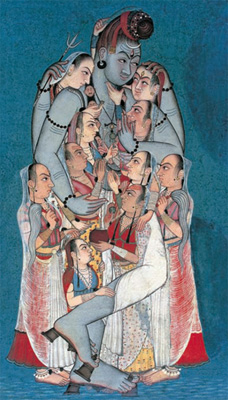
An unusual depiction of Shiva in which he embraces numerous adorers who shower their love and affection on him.
Suvarnanabha adds that a woman who lives as an ascetic and a widow may be considered as a sixth kind of nayika.
Ghotakamukha says that the daughters of a public woman or a female servant, who are still virgins, comprise a seventh kind of nayika.
Gonardiya is of the view that any woman born of a good family, but difficult to approach after she has come of age, is an eighth kind of nayika.
But these four latter kinds of nayikas do not differ much from the first four kinds, as there is no separate purpose in resorting to them. Therefore, in Vatsyayana's opinion, there are only four kinds of nayikas: the maid, the twice-married woman, the public woman, and the woman resorted to for a special purpose.
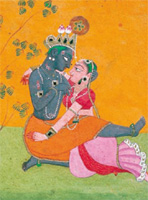
Radha and Krishna, the eternal lover in a loving embrace with their legs wrapped around each other. As he increases his touches and foreplay she looks lovingly into the eyes of her lord.
Women to Be Avoided
Certain women are not to be enjoyed: lunatics; outcasts; those with a loose and viperish tongue; who cannot keep a secret; who have an inordinate sexual urge difficult to satisfy; who are unsightly and unclean, and those who have lost the glow of youth.
Also forbidden are near relations, female friends, masculine women and women of holy orders; wives of relations, friends, learned Brahmins and the king.
Babhravya says that any woman who has been enjoyed by five men is a fit and proper person to be enjoyed. But Gonikaputra is of the opinion that even then, the wife of a relation, friend, learned Brahmin or a king should be made an exception.
The Ideal Messenger
A friend is identified as a childhood playmate, one to whom you are bound by an obligation, someone with the same disposition and fond of the same things as you, a fellow student, one familiar with your secrets and faults and whose faults are known to you, a child of your nurse, one with whom you have grown up, or the son of a family friend.
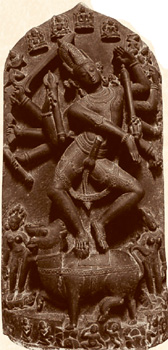
Lord Shiva devised the motion of dance as the most expressive means to convey the symbolism of mudra, gesture. The Pala dynasty’s voluminous and creative sculptural icons portrayed sexual power.
Such a friend should always tell the truth, rise above temptation, be amiable and support your cause, firm of character, free from covetousness, not easily won over by others, and who does not reveal your secrets. Charayana says that a nagaraka, man about town, may form friendships with washermen, barbers, cowherds, florists, druggists, betel-leaf sellers, tavern keepers, goldsmiths, pithamardas, vitas and vidushakas, and also with his wives.
A person, who is a loyal friend of both the nagaraka and the nayika is more to be trusted, and is a fit person to act as an intermediary or go-between in matters of amorous love.
A messenger should possess the following qualities: be eloquent, skillful and quick in repartee; bold but well-mannered; knowledgeable and ingenious; sensitive in correctly interpreting facial expressions and gestures; not easily confused or taken aback, and able to face any situation.
This part ends with the shloka:
The man who is ingenious and wise, who is accompanied by a friend, and who knows the intentions of others, as also the proper time and place for doing everything, can win over very easily, even a woman who is very hard to possess.

The famous Gyraspur Devi, an entrancingly singular aspect of femininity, sculptured by a master artisan in a style particular to Madhya Pradesh.
